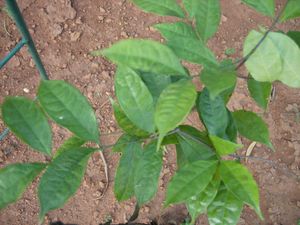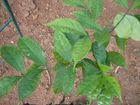Note: This is a project under development. The articles on this wiki are just being initiated and broadly incomplete. You can Help creating new pages.
Difference between revisions of "Salacia reticulata - Meharimula"
(Created page with "thumb|right|''Meharimula'', ''Salacia reticulata'', ''Kothala himbutu'' Meharimula or Kothala Himbutu is an indigenous Sri Lankan medicinal...") |
|||
| (13 intermediate revisions by 4 users not shown) | |||
| Line 1: | Line 1: | ||
[[File:Ekanayakam - plant 15.jpg|thumb|right|''Meharimula'', ''Salacia reticulata'', ''Kothala himbutu'']] | [[File:Ekanayakam - plant 15.jpg|thumb|right|''Meharimula'', ''Salacia reticulata'', ''Kothala himbutu'']] | ||
| + | '''Meharimula''' is an indigenous flowering plant of the genus Salacia grown in dry zone forests in Sri Lanka. Meharimula or Kothala Himbutu is an indigenous Sri Lankan medicinal plant, but also grown in some parts of Southern India. | ||
| + | ==Uses== | ||
| + | {{Uses|Diabetes}}, {{Uses|Salacia}}, {{Uses|Gonorrhea}}, {{Uses|Asthma}}, {{Uses|Itchiness}}, {{Uses|Joint pain}}, {{Uses|Obesity}}, {{Uses|Excess thirst}}, {{Uses|Menstrual problems}} | ||
| − | + | ==Parts Used== | |
| + | {{Parts Used|Roots}}. | ||
| − | + | ==Chemical Composition== | |
| + | 3-oxofriedelane, 3β-hydroxyfriedelane, β-sitosterol, 28-hydroxy-3-oxofriedelane and dulcitol were isolated from extracts of leaves as well as branches of S. elliptica. β-stearyloxy-olean-12-en, gutta-percha, 3,4-seco-friedelan-3-oic acid, palmitic acid, β-sistosterol glucoside, ethyl glucopyranoside.<ref name="chemical composition"/> | ||
| − | + | ==Common names== | |
| + | {{Common names|kn=|ml=|sa=|ta=kadalainjil, ponkoranti|te=|hi=|en=Oblong Leaf Salacia}} | ||
| − | + | ==Properties== | |
| + | Reference: Dravya - Substance, Rasa - Taste, Guna - Qualities, Veerya - Potency, Vipaka - Post-digesion effect, Karma - Pharmacological activity, Prabhava - Therepeutics. | ||
| + | ===Dravya=== | ||
| + | |||
| + | ===Rasa=== | ||
| + | Tikta (Bitter), Kashaya (Astringent) | ||
| + | ===Guna=== | ||
| + | Laghu (Light), Ruksha (Dry), Tikshna (Sharp) | ||
| + | ===Veerya=== | ||
| + | Ushna (Hot) | ||
| + | ===Vipaka=== | ||
| + | Katu (Pungent) | ||
| + | ===Karma=== | ||
| + | Kapha, Pitta | ||
| + | ===Prabhava=== | ||
| + | |||
| + | ==Habit== | ||
| + | {{Habit|Herb}} | ||
| + | |||
| + | ==Identification== | ||
| + | ===Leaf=== | ||
| + | {{Leaf|Simple|Elliptic – oblong|Leaves opposite, 6-12 x 3-6 cm, base acute, apex abruptly acuminate}}<ref name="Leaf"/> | ||
| + | |||
| + | ===Flower=== | ||
| + | {{Flower|Bisexual|3-6 cm across|Greenish white or greenish yellow|5-20|Flowers Season is June - August}} | ||
| + | |||
| + | ===Fruit=== | ||
| + | {{Fruit|General|7–10 mm|Clearly grooved lengthwise, Lowest hooked hairs aligned towards crown||1-4}} | ||
| + | |||
| + | ===Other features=== | ||
| + | |||
| + | ==List of Ayurvedic medicine in which the herb is used== | ||
| + | |||
| + | ==Where to get the saplings== | ||
| + | ==Mode of Propagation== | ||
| + | {{Propagation|Seeds}}, {{Propagation|Cuttings}}. | ||
| + | |||
| + | ==How to plant/cultivate== | ||
| + | <ref name="How to plant/cultivate"/> | ||
| + | |||
| + | ==Commonly seen growing in areas== | ||
| + | {{Commonly seen|Wet zone}}, {{Commonly seen|Dry zone forests}}. | ||
| + | |||
| + | ==Photo Gallery== | ||
| + | <gallery class="left" caption="" widths="140px" heights="140px"> | ||
| + | File:Salacia reticulata 12.JPG | ||
| + | File:Salacia reticulata, dried root.jpg | ||
| + | File:Salacia reticulata 11.JPG | ||
| + | File:Ekanayakam - plant 15.jpg | ||
| + | </gallery> | ||
| + | |||
| + | ==References== | ||
| + | |||
| + | <references> | ||
| + | <ref name="chemical composition">[http://www.scielo.br/scielo.php?script=sci_arttext&pid=S0100-40422010000400026 Chemical constitunets]</ref> | ||
| + | |||
| + | <ref name="Leaf">[http://www.gbpuat-cbsh.ac.in/departments/bi/database/phytodiabcare/phytodiab%20db/135.html Morphology]</ref> | ||
| + | |||
| + | <ref name="How to plant/cultivate">[Cultivation details]</ref> | ||
| + | </references> | ||
| + | [[Category:Ayurvedic herbs that don't have flower, fruit and leaf photos]] | ||
| + | [[Category:Ayurvedic herbs that don't have seed photos]] | ||
| + | |||
| + | ==External Links== | ||
| + | * [https://www.ncbi.nlm.nih.gov/pmc/articles/PMC5033029/ Anti‐diabetic and Anti‐hyperlipidemic Effects and Safety of Salacia reticulata and Related Species] | ||
| + | * [https://www.sciencedirect.com/science/article/pii/S0102695X13700978 Salacia reticulata on science direct] | ||
| + | * [https://easyayurveda.com/2016/08/09/saptachakra-qualities-uses-research-medicines/ Salacia reticulata on easy ayurveda.com] | ||
| + | * [http://frlhtenvis.nic.in/KidsCentre/Plant_1769.aspx Salacia reticulata on frlhtenvis.nic.in] | ||
[[Category:Herbs]] | [[Category:Herbs]] | ||
| + | [[Category:Celastraceae]] | ||
Latest revision as of 11:22, 3 August 2020
Meharimula is an indigenous flowering plant of the genus Salacia grown in dry zone forests in Sri Lanka. Meharimula or Kothala Himbutu is an indigenous Sri Lankan medicinal plant, but also grown in some parts of Southern India.
Contents
- 1 Uses
- 2 Parts Used
- 3 Chemical Composition
- 4 Common names
- 5 Properties
- 6 Habit
- 7 Identification
- 8 List of Ayurvedic medicine in which the herb is used
- 9 Where to get the saplings
- 10 Mode of Propagation
- 11 How to plant/cultivate
- 12 Commonly seen growing in areas
- 13 Photo Gallery
- 14 References
- 15 External Links
Uses
Diabetes, Salacia, Gonorrhea, Asthma, Itchiness, Joint pain, Obesity, Excess thirst, Menstrual problems
Parts Used
Chemical Composition
3-oxofriedelane, 3β-hydroxyfriedelane, β-sitosterol, 28-hydroxy-3-oxofriedelane and dulcitol were isolated from extracts of leaves as well as branches of S. elliptica. β-stearyloxy-olean-12-en, gutta-percha, 3,4-seco-friedelan-3-oic acid, palmitic acid, β-sistosterol glucoside, ethyl glucopyranoside.[1]
Common names
| Language | Common name |
|---|---|
| Kannada | |
| Hindi | |
| Malayalam | |
| Tamil | kadalainjil, ponkoranti |
| Telugu | |
| Marathi | NA |
| Gujarathi | NA |
| Punjabi | NA |
| Kashmiri | NA |
| Sanskrit | |
| English | Oblong Leaf Salacia |
Properties
Reference: Dravya - Substance, Rasa - Taste, Guna - Qualities, Veerya - Potency, Vipaka - Post-digesion effect, Karma - Pharmacological activity, Prabhava - Therepeutics.
Dravya
Rasa
Tikta (Bitter), Kashaya (Astringent)
Guna
Laghu (Light), Ruksha (Dry), Tikshna (Sharp)
Veerya
Ushna (Hot)
Vipaka
Katu (Pungent)
Karma
Kapha, Pitta
Prabhava
Habit
Identification
Leaf
| Kind | Shape | Feature |
|---|---|---|
| Simple | Elliptic – oblong | Leaves opposite, 6-12 x 3-6 cm, base acute, apex abruptly acuminate |
Flower
| Type | Size | Color and composition | Stamen | More information |
|---|---|---|---|---|
| Bisexual | 3-6 cm across | Greenish white or greenish yellow | 5-20 | Flowers Season is June - August |
Fruit
| Type | Size | Mass | Appearance | Seeds | More information |
|---|---|---|---|---|---|
| General | 7–10 mm | Clearly grooved lengthwise, Lowest hooked hairs aligned towards crown | 1-4 | {{{6}}} |
Other features
List of Ayurvedic medicine in which the herb is used
Where to get the saplings
Mode of Propagation
How to plant/cultivate
Commonly seen growing in areas
Photo Gallery
References
- ↑ Chemical constitunets
- ↑ Morphology
- ↑ [Cultivation details]
External Links
- Ayurvedic Herbs known to be helpful to treat Diabetes
- Ayurvedic Herbs known to be helpful to treat Salacia
- Ayurvedic Herbs known to be helpful to treat Gonorrhea
- Ayurvedic Herbs known to be helpful to treat Asthma
- Ayurvedic Herbs known to be helpful to treat Itchiness
- Ayurvedic Herbs known to be helpful to treat Joint pain
- Ayurvedic Herbs known to be helpful to treat Obesity
- Ayurvedic Herbs known to be helpful to treat Excess thirst
- Ayurvedic Herbs known to be helpful to treat Menstrual problems
- Herbs with Roots used in medicine
- Herbs with common name in Tamil
- Herbs with common name in English
- Habit - Herb
- Index of Plants which can be propagated by Seeds
- Index of Plants which can be propagated by Cuttings
- Herbs that are commonly seen in the region of Wet zone
- Herbs that are commonly seen in the region of Dry zone forests
- Ayurvedic herbs that don't have flower, fruit and leaf photos
- Ayurvedic herbs that don't have seed photos
- Herbs
- Celastraceae




